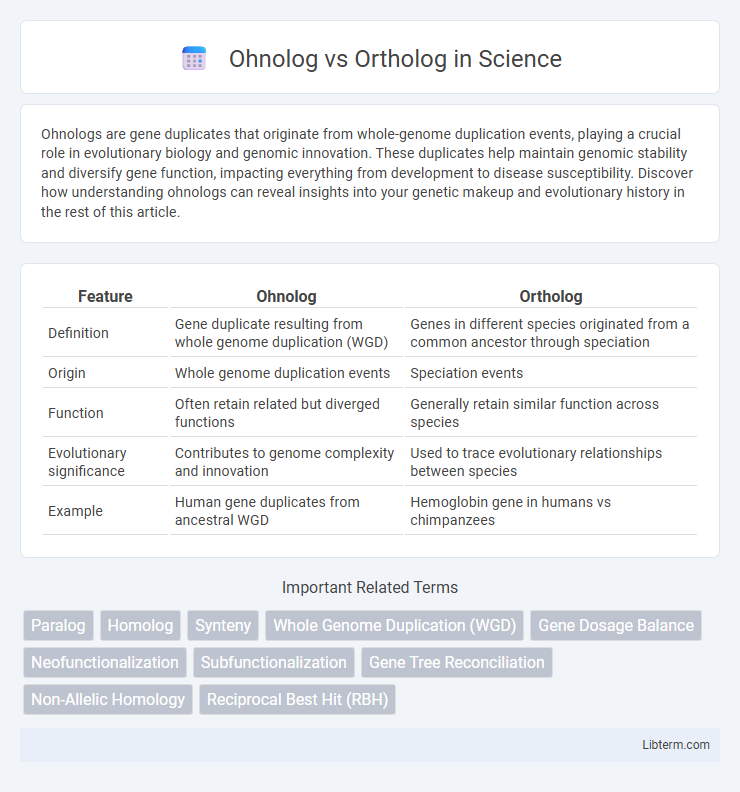Ohnologs are gene duplicates that originate from whole-genome duplication events, playing a crucial role in evolutionary biology and genomic innovation. These duplicates help maintain genomic stability and diversify gene function, impacting everything from development to disease susceptibility. Discover how understanding ohnologs can reveal insights into your genetic makeup and evolutionary history in the rest of this article.
Table of Comparison
| Feature | Ohnolog | Ortholog |
|---|---|---|
| Definition | Gene duplicate resulting from whole genome duplication (WGD) | Genes in different species originated from a common ancestor through speciation |
| Origin | Whole genome duplication events | Speciation events |
| Function | Often retain related but diverged functions | Generally retain similar function across species |
| Evolutionary significance | Contributes to genome complexity and innovation | Used to trace evolutionary relationships between species |
| Example | Human gene duplicates from ancestral WGD | Hemoglobin gene in humans vs chimpanzees |
Understanding Ohnologs and Orthologs
Ohnologs are gene duplicates resulting from whole-genome duplication events, playing a crucial role in evolutionary innovation and complexity. Orthologs are genes in different species that evolved from a common ancestral gene through speciation, retaining similar functions across species. Understanding ohnologs involves studying gene dosage balance and evolutionary constraints, while ortholog analysis is essential for functional annotation and comparative genomics.
Evolutionary Origins: Ohnologs vs Orthologs
Ohnologs arise from whole-genome duplication events, retaining duplicated genes within the same species that often contribute to genomic complexity and evolutionary innovation. Orthologs originate from speciation events, representing homologous genes in different species that maintain similar functions inherited from a common ancestor. Understanding the evolutionary origins distinguishes ohnologs as paralogs formed through polyploidy, whereas orthologs serve as critical markers for tracing species divergence and functional conservation.
Gene Duplication and Ohnolog Formation
Ohnologs are gene duplicates originating specifically from whole-genome duplication events, preserving synteny and often retaining essential biological functions. Orthologs, in contrast, arise from speciation events and typically maintain functional similarity across different species. Gene duplication through whole-genome duplication generates ohnologs, which contribute to genomic complexity and evolutionary innovation by retaining redundant genetic material that can diversify or acquire new functions.
Speciation and the Rise of Orthologs
Orthologs arise through speciation events, where genes in different species diverge from a common ancestral gene, maintaining similar functions across species. Ohnologs result from whole-genome duplication events, creating paralogous gene copies within the same genome that can acquire new functions or regulatory patterns. The rise of orthologs is a key aspect of evolutionary biology, essential for studying functional conservation and divergence among species.
Functional Differences Between Ohnologs and Orthologs
Ohnologs, resulting from whole-genome duplications, often retain redundant functions or diverge to acquire novel roles, enhancing organismal complexity, whereas orthologs, derived from speciation events, typically maintain conserved functions across species. Functional differences between ohnologs may include subfunctionalization or neofunctionalization, leading to diversified gene expression patterns and biochemical activities not commonly observed in orthologs. Orthologs usually preserve core biological processes, while ohnologs contribute to evolutionary innovation and adaptation by expanding gene functional repertoires.
Detecting and Identifying Ohnologs
Ohnologs are gene duplicates arising from whole-genome duplication events and are identified by analyzing synteny blocks and phylogenetic profiles across species. Detecting ohnologs involves comparing conserved chromosomal regions and leveraging genomic databases like Ensembl or OhnologsDB that catalog these duplicates. Orthologs, by contrast, are genes in different species that originated from a single ancestral gene through speciation, detected primarily via sequence similarity and phylogenetic tree reconciliation.
Methods for Recognizing Orthologs
Methods for recognizing orthologs primarily involve sequence similarity searches, phylogenetic tree reconstructions, and synteny analysis to distinguish orthologous genes from paralogs such as ohnologs. Tools like OrthoFinder and InParanoid utilize graph-based clustering and sequence homology metrics to identify orthologs across multiple species. Incorporating evolutionary context through gene trees aids in resolving complex duplication events, enhancing the accuracy of ortholog assignment compared to ohnolog detection.
Biological Significance of Ohnologs
Ohnologs are gene duplicates originating from whole-genome duplication events, playing a crucial role in evolutionary innovation and complexity in vertebrates. These duplicates contribute to developmental robustness, genetic redundancy, and the diversification of physiological functions, often implicated in disease susceptibility due to their dosage sensitivity. Unlike orthologs, which arise from speciation and retain similar functions across species, ohnologs provide insight into genome evolution and the molecular basis of vertebrate-specific traits.
Orthologs in Comparative Genomics
Orthologs are genes in different species that evolved from a common ancestral gene through speciation events, preserving similar functions across diverse organisms. In comparative genomics, identifying orthologs enables the reconstruction of evolutionary relationships and functional annotation by highlighting conserved sequences between species. Analyzing orthologs provides critical insights into gene conservation, evolutionary divergence, and the genetic basis of phenotypic traits across lineages.
Implications for Human Disease Research
Ohnologs, gene duplicates originating from whole-genome duplications, often retain dosage sensitivity, which is crucial for understanding complex genetic disorders and phenotypic variability in humans. Orthologs, derived from speciation events, provide evolutionary conservation insights that aid in identifying functionally important genes across species but may lack the dosage balance seen in ohnologs. Studying ohnologs enhances the identification of disease-associated gene networks and potential therapeutic targets by highlighting genes with critical dosage constraints linked to human diseases such as cancer and developmental disorders.
Ohnolog Infographic

 libterm.com
libterm.com